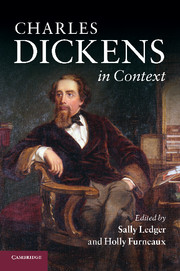Book contents
- Frontmatter
- Contents
- List of illustrations
- Notes on contributors
- Preface
- Notes on references
- PART I LIFE AND AFTERLIFE
- PART II SOCIAL AND CULTURAL CONTEXTS
- 12 Popular culture
- 13 The rise of celebrity culture
- 14 The newspaper and periodical market
- 15 Authorship and the professional writer
- 16 The theatre
- 17 Melodrama
- 18 The Bildungsroman
- 19 Visual culture
- 20 The historical novel
- 21 The illustrated novel
- 22 Christmas
- 23 Childhood
- 24 Work
- 25 Europe
- 26 The Victorians and America
- 27 Educating the Victorians
- 28 London
- 29 Politics
- 30 Political economy
- 31 The aristocracy
- 32 The middle classes
- 33 Urban migration and mobility
- 34 Financial markets and the banking system
- 35 Empires and colonies
- 36 Race
- 37 Crime
- 38 The law
- 39 Religion
- 40 Science
- 41 Transport
- 42 Illness, disease and social hygiene
- 43 Domesticity
- 44 Sexuality
- 45 Gender identities
- Further reading
- Index
12 - Popular culture
Published online by Cambridge University Press: 05 August 2012
- Frontmatter
- Contents
- List of illustrations
- Notes on contributors
- Preface
- Notes on references
- PART I LIFE AND AFTERLIFE
- PART II SOCIAL AND CULTURAL CONTEXTS
- 12 Popular culture
- 13 The rise of celebrity culture
- 14 The newspaper and periodical market
- 15 Authorship and the professional writer
- 16 The theatre
- 17 Melodrama
- 18 The Bildungsroman
- 19 Visual culture
- 20 The historical novel
- 21 The illustrated novel
- 22 Christmas
- 23 Childhood
- 24 Work
- 25 Europe
- 26 The Victorians and America
- 27 Educating the Victorians
- 28 London
- 29 Politics
- 30 Political economy
- 31 The aristocracy
- 32 The middle classes
- 33 Urban migration and mobility
- 34 Financial markets and the banking system
- 35 Empires and colonies
- 36 Race
- 37 Crime
- 38 The law
- 39 Religion
- 40 Science
- 41 Transport
- 42 Illness, disease and social hygiene
- 43 Domesticity
- 44 Sexuality
- 45 Gender identities
- Further reading
- Index
Summary
As Britain underwent transformation in the nineteenth century from a stable, predominantly rural, agriculturally based society into an urban, industrial state, the culture of the people was inevitably subject to fundamental change. Age-old traditions were eroded by multiple pressures, and during the second quarter of the century, when poverty was widespread and inequality dire, few new forms of popular culture had emerged to take their place.
For centuries up until around the time Dickens was born in 1812, the majority of the British population lived and worked in the countryside, where the cycle of the seasons regulated their lives. People got jobs at hiring fairs, or mops; spring renewal was marked by May Day rituals; harvest homes celebrated the end of the growing season; Christmas and summer solstice were occasions for communal enjoyment. Itinerant individual showmen travelled an annual circuit from village to village, assembling together at local fairs. Many of these fairs had been offering the same sorts of entertainment since the Middle Ages: stilt-walking, puppet shows, singing, dancing, performing animals, freaks and games. Most fairs had long since ceased to have any significant commercial function, but provided annual holiday recreation and entertainment. Violent sports such as bull-baiting and cock-fighting had largely disappeared, but amusement was robust, largely male, and well lubricated by drink.
- Type
- Chapter
- Information
- Charles Dickens in Context , pp. 91 - 97Publisher: Cambridge University PressPrint publication year: 2011

